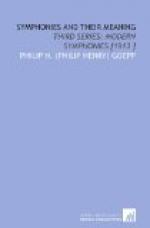On the whole, the tragedy seems to be one of those daring, even profane assaults on elemental questions by ways that are untrodden if not forbidden. It is a wonderful type of Romanticist poetry in the bold choice of subject and in the intense vigor and beauty of the verse. Coming with a shock upon the classic days of German poetry, it met with a stern rebuke from the great Goethe. But a century later we must surely halt in following the lead of so severe a censor. The beauty of diction alone seems a surety of a sound content,—as when Penthesilea exclaims:
“A hero man can be—a
Titan—in distress,
But like a god is he when
rapt in blessedness.”
An almost convincing symbolism has been suggested of the latent meaning of the poem by a modern critic,[A]—a symbolism that seems wonderfully reflected in Wolff’s music. The charge of perverted passion can be based only on certain lines, and these are spoken within the period of madness that has overcome the heroine. This brings us to the final point which may suggest the main basic fault in the poem, considered as art. At least it is certainly a question whether pure madness can ever be a fitting subject in the hero of a tragedy. Ophelia is an episode; Hamlet’s madness has never been finally determined. Though the Erinnys hunted Orestes in more than one play, yet no single Fury could, after all, be the heroine of tragedy. Penthesilea became in the crisis a pure Fury, and though she may find here her own defense, the play may not benefit by the same plea. On the other hand, the madness is less a reality than an impression of the Amazons who cannot understand the heroine’s conflicting feelings. There is no one moment in the play when the hearer’s sympathy for the heroine is destroyed by a clear sense of her insanity.
[Footnote A: Kuno Francke. See the notes of Philip Hale in the programme book of the Boston Symphony Orchestra of April 3-4, 1908.]
For another word on the point of symbolism, it must be remembered that the whole plot is one of supernatural legend where somehow human acts and motives need not conform to conventional rule, and where symbolic meaning, as common reality disappears, is mainly eminent. It is in this same spirit that the leading virtues of the race, of war or of peace, are typified by feminine figures.
The Tragedy is not divided into acts; it has merely four and twenty scenes—upon the battle-field of Troy. The characters are Penthesilea, Queen of the Amazons; her chief leaders, Prothoe, Meroe and Asteria, and the high priestess of Diana. Of the Greeks there are Achilles, Odysseus, Diomede and Antilochus. Much of the fighting and other action is not seen, but is reported either by messengers or by present witnesses of a distant scene.
The play begins with the battle raging between Greeks and Amazons. Penthesilea with her hosts amazes the Greeks by attacking equally the Trojans, her reputed allies. She mows down the ranks of the Trojans, and yet refuses all proffers of the Greeks.




